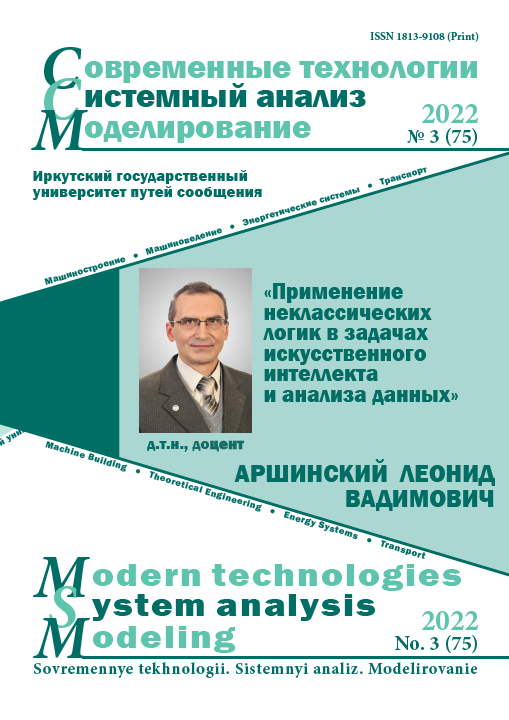Modeling of the formation of the main quality indicators of the surface layer of parts during shot-impact hardening
Keywords:
shot-impact hardening, hardened layer, residual stresses, modeling, surface layer qualityAbstract
One of the effective finishing operations is shot-impact blasting in which, under the impact influence of the shot on the surface of the workpiece, surface plastic deformation occurs, providing the specified characteristics of the material of the parts. In the aircraft industry to increase the fatigue resistance of aircraft panels and wing skins operating under cyclic loads, after the process of their shaping and grinding with a flap wheel, such parts are subjected to shot-impact hardening. The control parameters of the shot-impact hardening process are surface roughness, microhardness, the size of the hardened layer, residual stresses, etc. At the same time, while the surface roughness and microhardness are not difficult to determine by traditional methods determining the size of the hardened layer and residual stresses is a more complex and time-consuming task. Recently, with the development of information technology, various engineering analysis programs have been increasingly used to study various complex technological processes, including shot-impact processing. In the present paper, a study of the formation of a hardened layer and residual stresses in the surface layer caused by the operation of shot-impact hardening of an aluminum alloy part using an engineering analysis program by the finite element method is carried out. According to the results of the study, visual pictures of the stress-strain state of the surface layer after the impact of the shot with the treated surface are presented, graphical distributions of residual stresses along the depth in the surface layer and the dependence of the values of maximum residual stresses on the diameter and velocity of the shot impact are presented, recommendations on the choice of conditions and modes for shot-impact hardening are developed, as well as mathematical models for determining the value of the hardened layer and the maximum residual stresses in the surface layer of the part.
References
Обработка деталей поверхностным пластическим деформированием / И.Р. Асланян, А.С. Бубнов, В.Н. Емельянов и др. Иркутск : ИрГТУ, 2014. 559 с.
Пашков А.Е., Шматков В.С. Особенности технологии дробеударного упрочнения крупногабаритных деталей самолетов // Управление технологическими процессами машиностроительного производства : сб. ст. Иркутск, 1998. С. 62–66.
Пашков А.Е. Об особенностях применения Отечественной и зарубежной технологии формообразования обшивок и панелей самолетов // Вестн. Иркут. гос. техн. ун-та. 2015. № 5 (100). С. 17–22.
Пашков А.Е., Малащенко А.Ю., Пашков А.А. К вопросу создания цифровых технологий производства крупногабаритных деталей каркаса и обшивки самолета // Технология металлов. 2021. № 1. С. 36–46.
Гребенников Д.С., Максименков В.И. Формообразование панелей крыла дальнемагистрального самолета // Вестн. Воронеж. гос. техн. ун-та. 2019. Т. 15. № 1. С. 116–121.
Пашков А.А. Моделирование процесса формообразования крупногабаритных деталей двойной кривизны на дробеметных установках контактного типа // Технология металлов. 2020. № 12. С. 19–28.
Пашков А.Е., Дияк А.Ю. Определение параметров дробеударного формообразования-упрочнения при помощи CAD/CAM/CAE систем // Управление технологическими процессами машиностроительного производства : сб. ст. Иркутск : Иркут. гос. техн. ун-т, 1998. С. 62–66.
Meguid S.A., G. Shagal, J.C. Stranart, J.Daly. Tree-dimensional dynamic finite element analysis of shot-peening induced residual stresses // Finite Elements in Analysis and Design. 1999. P. 13. DOI 10.1016/S0168-874X(98)00057-2.
Baragetti S. Three-dimensional finite-element procedures for shot peening residual stress field prediction // International Journal of Computer Applications in Technology. 2001. Vol. 14. Is. 1-3. P. 51–63.
Miao H. Y. On the potential applications of a 3D random finite element model for the simulation of shot peening / H. Y. Miao, S. Larose, C. Per-ron et al. // Adv. Eng. Softw. 2009. Vol. 40. P. 1023–1038.
Zhuo Chen., Yang Fan, Meguid S. A. Realistic Finite Element Simulations of Arc-Height De-velopment in Shot-Peened Almen Strips // Journal of Engineering Materials and Technology. 2014. Vol. 136. DOI 10.1115/1.4028006.
Bhuvaraghan B. Shot peening simulation using discrete and finite element methods / B. Bhuvaraghan, S. M. Srinivasan, O. Prakash et al. // Advances in Engineering Software. 2010. Vol. 41. Is. 12. P. 1266–1276.
Касимов Б. М-у., Муминов М.Р., Шин И.Г. Поверхностное упрочнение деталей технологических оборудований и моделирование напряженного состояния при дробеударной обработке // Сб. науч. трудов Междунар. науч. конф., посвящ. 150-летию со дня рождения проф. Н.А. Васильева. Москва, 2021. С. 122–127.
Методика расчета технологических параметров превентивного деформирования упрочняемых деталей типа «стенка» / А.А. Макарук, О.В. Самойленко, Ю.Н. Иванов и др. // Вестн. Иркут. гос. техн. ун-та. 2021. Т. 25. № 1(156). С. 8–16.
Определение внутренних силовых факторов, возникающих при упрочнении подкрепленных ребрами деталей /
А.А. Макарук, А.А. Пашков, А.М. Хамаганов и др. // Вестн. Иркут. гос. техн. ун-та. 2018. Т. 22. № 10 (141). С. 29–37.
Makaruk A.A. Pashkov A.A., Samoylenko O.V. Increasing the shape accuracy of the hardened parts of the frame by technological methods // International Conference on Innovations in Automotive and Aerospace Engineering, ICI2AE 2019, Irkutsk, 2019. Vol. 632. p. 012100. DOI 10.1088/1757-899X/632/1/012100.
Назаров С.Р., Шодмонкулов З.А. Определение глубины деформационного упрочнения на основе энергетических соотношений дробеударной обработки // Материалы докладов 54-й Международной научно-технической конференции преподавателей и студентов. Витебск, 2021. Т. 2. С. 279–281.
Дрозд М.С., Осипенко А.П. Аналитическое исследование напряженного состояния при внедрении упругой сферы в упруго-пластическое полупространство // Металловедение и прочность металлов : сб. науч. тр. Волгоград, 1977. Вып. 8. С. 58–68.
Определение рациональных технологических режимов упрочняющей дробеобработки стальных деталей / М.М. Матлин, А.И. Мозгунова, В.О. Мосейко и др. // Изв. Волгоград. гос. техн. ун-та. 2014. № 9 (136). С. 99–102.
Матлин М.М., Мозгунова А.И., Лебский С.Л. Прогнозирование параметров упрочнения деталей машин путем поверхностного пластического деформирования // Изв. Волгоград. гос. техн. ун-та. 2005. № 3. С. 52–55.
Лебеденко В.Г. Математическое моделирование процесса формирования геометрических параметров поверхностного слоя и параметров упрочнения при обработке деталей дроби // Вестник ДГТУ. 2008. Т. 8. № 4 (39). С. 202–212.
Кравченко Г.Н., Кравченко К.Г. Выбор технологических параметров дробеударного упрочнения силовых деталей авиационных конструкций // Полет. 2018. № 12. С. 37–44.
Ле Чи Винь, Кольцов В.П., Нгуен Минь Хоанг. Моделирование формирования основных параметров качества поверхностного слоя при дробеударном упрочнении // Авиамашиностроение и транспорт Сибири : сб. ст. XIV Междунар. науч.-техн. конф. Иркутск, 2020. С. 104–112.


